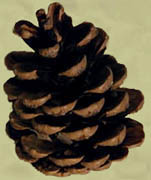 Northwoods Vacationland Album |
Promoting Happier Living Through Fond Memories ... Site Map |
|
 Northwoods Vacationland Album |
Promoting Happier Living Through Fond Memories ... Site Map |
|
|
Minnesota Dennis Anderson: HAYWARD, WIS. -- Here in the land of tall trees and blue water, Ted Dzialo has found a home in the shadow of a very big fish: the sequoia-size fiberglass muskie at the National Fresh Water Fishing Hall of Fame. Dzialo, executive director of the Hall of Fame, was a superintendent at a Chicago copper and brass mill until 1970, when he left the city of wind and smokestacks for the same north woods quality of life that years earlier attracted another Chicagoan, Al Capone. Capone came north in the 1920s at the height of his infamy, when prohibition was in full swing -- a perfect time for a gangster to purchase 400 acres and build a fancy spread on Pike Lake, not far from Hayward. Yet not even Capone stands out among the many characters that for generations have gathered in and around Hayward. Some, like the Chicago tough guys Capone brought with him, including "Machine Gun" Jack McGurn, were of ill repute. Others, like Dzialo, spent long years toiling in faraway places before breaking away. "I first fished in the Hayward area when I was 16," Dzialo said. "I was 37 before I moved here for good." Excluding the Great Lakes, Minnesota is a better and more varied fishing state than Wisconsin. But Wisconsin has the better muskie fishery, at least if tradition and lore are considered. I was saying as much the other day to my boys, Big and Little, as we, together with a friend of theirs, walked into a bar in downtown Hayward. Once inside, our intent was to see the world's largest muskie, a 67 1/2-pounder caught in 1949 by Cal Johnson. Johnson's fish measured 60 1/4 inches long, with a girth of 33 1/2 inches. "Why is it," Big asked as I swung open the door to the Moccasin Bar, "that record fish and record turkeys are always displayed in bars?" Big was referring to the opening of Minnesota's trout season last spring, when I dragged him and his brother into another bar, this one in Elba, Minn. Therein, perched behind glass, was the Minnesota state record turkey. "There's no easy way to answer that question," I said, "except to say that the marketing of beer takes on many forms. "Some days it's big fish. Other days, turkeys. Still other days, bikinis." Yet nothing is quite so simple, especially regarding Johnson's fish and its status as the world's record muskie. Johnson surely caught the fish, but it's the muskie of another Hayward-area resident, the fabled Louie Spray, that is recognized as the world record by the National Fresh Water Fishing Hall of Fame. Spray's muskie, also caught in 1949, weighed 69 pounds, 11 ounces. Amazingly, the fish was Spray's third world-record muskie. "We recognize Spray's muskie as the world record, but the IGFA [International Game Fish Association] recognizes Johnson's," Dzialo said. "The IGFA doesn't recognize Spray's record because he shot it with a pistol before hauling it into the boat. That was legal at the time, which is why we recognize the record. "But the IGFA doesn't recognize shooting a fish as a way to land it." A one-time lumberjack, bootlegger and bar owner, Spray would have been a northern Wisconsin legend even if he had never picked up a fishing rod. But he did, and by most accounts he fished obsessively for big muskies. Spray's first world record, weighing 59 1/2 pounds, was caught in Grindstone Lake on July 27, 1939. His next record fish, caught in 1940, was taken from Lac Court Oreilles and weighed 61 pounds, 13 ounces. Both lakes are near Hayward. The second record held until 1949, when Johnson, a one-time newspaper outdoors writer and fishing editor of Sports Afield, tagged the 67 1/2-pounder that today hangs in the Mocassin Bar. "Is that the real fish," Little asked. "or a fake one?" "They say it's the real thing," I said. So real -- and so big -- that at the time it was caught, WCCO Radio sent its star, Cedric Adams, to do his live evening broadcast from the Potato Festival at nearby Sarona, Wis. There Adams chatted with Johnson and Spray -- with Spray being in the rare position, by dint of Johnson's record fish, of playing second fiddle. But Spray would regain the title. Three months after Johnson caught his record muskie, Spray caught his 69-pound, 11-ounce specimen on Oct. 20, 1949 -- a month during which Spray vowed he would fish every day in an attempt to top Johnson's record. So it is that visitors to Hayward's National Fresh Water Fishing Hall of Fame, with its sequoia-size fiberglass muskie, are regaled not only with one of the finest collections of fishing paraphernalia in the world but with tall tales as well. All of them true. But you won't see Spray's record muskie at the Hall of Fame. It burned in a fire. And Johnson's record muskie? "I know, I know," Big said. "It's in a bar."
Dennis Anderson is at danderson@startribune.com.
|
 
|